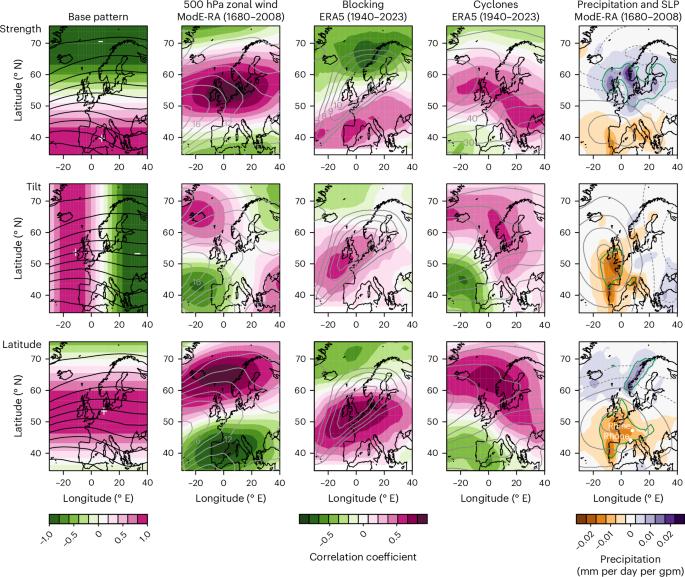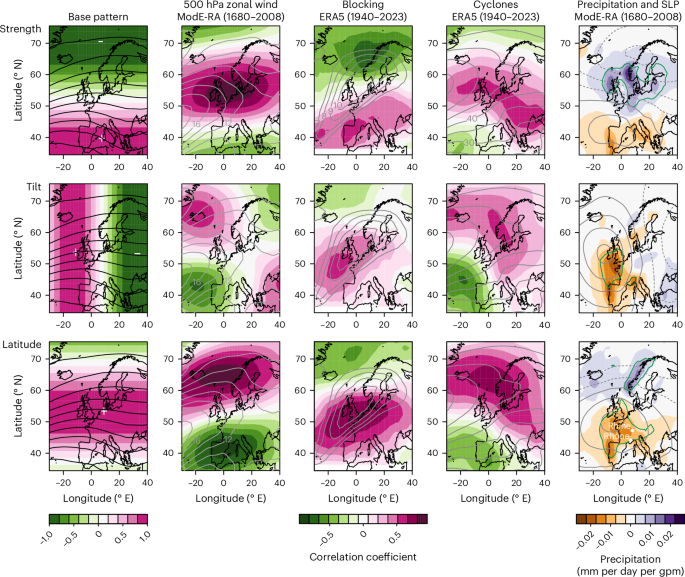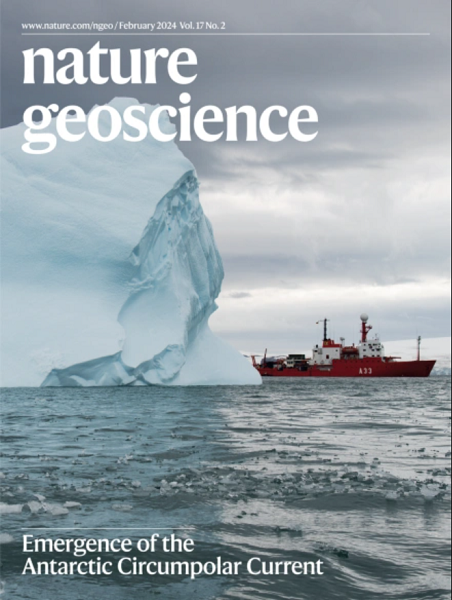欧洲过去的极端水文气候是由大西洋急流和反复出现的天气模式造成的
IF 16.1
1区 地球科学
Q1 GEOSCIENCES, MULTIDISCIPLINARY
引用次数: 0
摘要
大西洋-欧洲扇区上空的急流与欧洲的天气和气候有关。它产生极端温度,并将潮湿和洪水驱动的天气系统引向欧洲,或者促进大气块的发展,这可能导致干旱。持续的气候变化可能会改变喷气机的特征,影响极端天气。然而,人们对过去急流的年际-年代际变化知之甚少。在这里,我们分析了1421年至2023年大西洋-欧洲急流的强度、倾斜度和纬度,这些数据来自逐月和逐日的大气场重建。我们比较了这些急流指数与阻塞频率和气旋活动数据以及欧洲干旱和洪水重建的变异性。在有极移急流的时期,中欧夏季干旱加剧。赤道移动的急流与阻塞减少有关,导致西欧和阿尔卑斯山频繁发生洪水,特别是在冬季。引起洪水的反复出现的天气模式往往是整个季节的特征,因此在季节性甚至年度尺度上可以看到峰值流量和急流指数之间的关联。喷流强度和倾斜度受火山喷发的显著影响。从600年的角度来看,近期喷气指数的变化是在过去的变率范围内,不可能成为洪水和干旱频率增加的驱动因素。本文章由计算机程序翻译,如有差异,请以英文原文为准。


Past hydroclimate extremes in Europe driven by Atlantic jet stream and recurrent weather patterns
The jet stream over the Atlantic–European sector is relevant for weather and climate in Europe. It generates temperature extremes and steers moisture and flood-propelling weather systems to Europe or facilitates the development of atmospheric blocks, which can lead to drought. Ongoing climate change may alter the jet characteristics, affecting weather extremes. However, little is known about the past interannual-to-decadal variability of the jet stream. Here we analyse the strength, tilt and latitude of the Atlantic–European jet from 1421 to 2023 in an ensemble of monthly and daily reconstructions of atmospheric fields. We compare the variability of these jet indices with blocking frequency and cyclonic activity data and with drought and flood reconstructions in Europe. Summer drought is enhanced in Central Europe in periods with a poleward-shifted jet. An equatorward-shifted jet associated with decreased blocking leads to frequent floods in Western Europe and the Alps, particularly in winter. Recurrent weather patterns causing floods often characterize an entire season, such that an association between peak discharge and jet indices is seen on seasonal or even annual scales. Jet strength and tilt are significantly influenced by volcanic eruptions. Our 600-year perspective shows that recent changes in the jet indices are within the past variability and cannot be drivers of increasing flood and drought frequency. European climate extremes during the past 600 years were in large part driven by changes in the position and strength of the jet stream over the Atlantic, according to an analysis of terrestrial hydroclimate records.
求助全文
通过发布文献求助,成功后即可免费获取论文全文。
去求助
来源期刊

Nature Geoscience
地学-地球科学综合
CiteScore
26.70
自引率
1.60%
发文量
187
审稿时长
3.3 months
期刊介绍:
Nature Geoscience is a monthly interdisciplinary journal that gathers top-tier research spanning Earth Sciences and related fields.
The journal covers all geoscience disciplines, including fieldwork, modeling, and theoretical studies.
Topics include atmospheric science, biogeochemistry, climate science, geobiology, geochemistry, geoinformatics, remote sensing, geology, geomagnetism, paleomagnetism, geomorphology, geophysics, glaciology, hydrology, limnology, mineralogy, oceanography, paleontology, paleoclimatology, paleoceanography, petrology, planetary science, seismology, space physics, tectonics, and volcanology.
Nature Geoscience upholds its commitment to publishing significant, high-quality Earth Sciences research through fair, rapid, and rigorous peer review, overseen by a team of full-time professional editors.
 求助内容:
求助内容: 应助结果提醒方式:
应助结果提醒方式:


